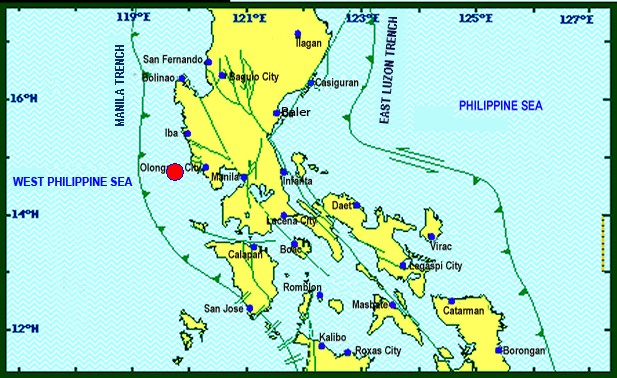OLONGAPO CITY, Zambales, Philippines – A magnitude 5.9 earthquake jolted out of their beds many residents of the Zambales province and parts of Luzon island on Sunday morning but no damage or casualty was reported, disaster response and local officials said.
Gracela Macabare, head of the Zambales Provincial Disaster Risk Reduction and Management Office (PDRRMO), said her office had not received reports of any earthquake-related damage in the province as of Sunday afternoon.
A bulletin released by the Philippine Institute of Volcanology and Seismology (Phivolcs) on Sunday noon said the epicenter was 30 kilometers southwest of San Antonio town in Zambales.
Macabare, however, said residents of San Antonio did not report any damage to their houses or government and private structures in the town.
Erwell Sadernas, barangay (village) chairman of Pundaquit in San Antonio, said many residents rushed outside their houses when they felt the ground shaking at 3:32 a.m.
“The tremor was strong enough to rouse almost all us here from sleep. Since we live near the sea, instinct prompted us to rush outside our homes and find a safe place,” he said.
Sadernas said despite the ground shaking in their coastal village, the earthquake did not leave cracks on their walls.
The tremor was followed by a 2.3 magnitude earthquake at 5:08 a.m., also in San Antonio, the Phivolcs said. That earthquake’s epicenter was 20 km southwest of the town.
Recently, a boulder the size of a car fell from a cliff side in Capones Island in San Antonio and killed a hiker.
Local authorities said a tremor that shook the cliff on Dec. 31 could have caused a section to collapse.
With another earthquake striking San Antonio, Sadernas said he would ask town officials to warn tourists against going to the area in Capones Island where the rock slide happened on Jan. 1.
The National Grid Corporation of the Philippines (NGCP) said its power transmission services remained normal despite the earthquake.
“The Luzon grid remains intact as there had been no reported cases of power interruptions and damaged transmission facilities in Zambales, Bataan and nearby areas where the earthquake was felt,” NGCP said in a statement.
Phivolcs said the earthquake was felt at Intensity V in San Antonio, Botolan, Subic, San Felipe and San Narciso towns and Olongapo City, all in Zambales.
It was felt at Intensity IV in the cities of Pateros, Pasig, Manila, Quezon, Makati, Parañaque, Malabon and Pasay City in Metro Manila; San Mateo, Binangonan and Montalban in Rizal province; Hagonoy and Obando towns in Bulacan province; Dagupan City and Lingayen town in Pangasinan province; Indang and Kawit in Cavite province; Bacolor town, Angeles City and Clark Freeport in Pampanga province; Mariveles town in Bataan province; and Pakil and Los Baños towns in Laguna province.
It was felt at Intensity III was felt in Tagaytay City; San Miguel town in Tarlac province; Baler town in Aurora province; Gapan City in Nueva Ecija province; and Sta. Barbara town in Pangasinan.
Residents in Baguio City, Batangas City and Puerto Galera in Oriental Mindoro felt the earthquake at Intensity II.
Intensity V means almost everybody feels the shaking indoors and outdoors and the earthquake is strong enough to wake up sleeping people, make doors swing, push dishes off the shelves and pictures off the walls and shake trees.
Intensity IV means most of the people indoors would feel the shaking and the earthquake is strong enough to make hanging objects swing, dishes, windows and doors to rattle and some parked cars outside to rock. Only a few people outdoors would feel the shaking.
Intensity III means that while many people indoors feel the tremor and would see hanging objects swing, people outdoors would hardly feel the shaking.
Intensity II means that a few people would feel the tremor if they are at rest inside and on the upper floor of a building.
